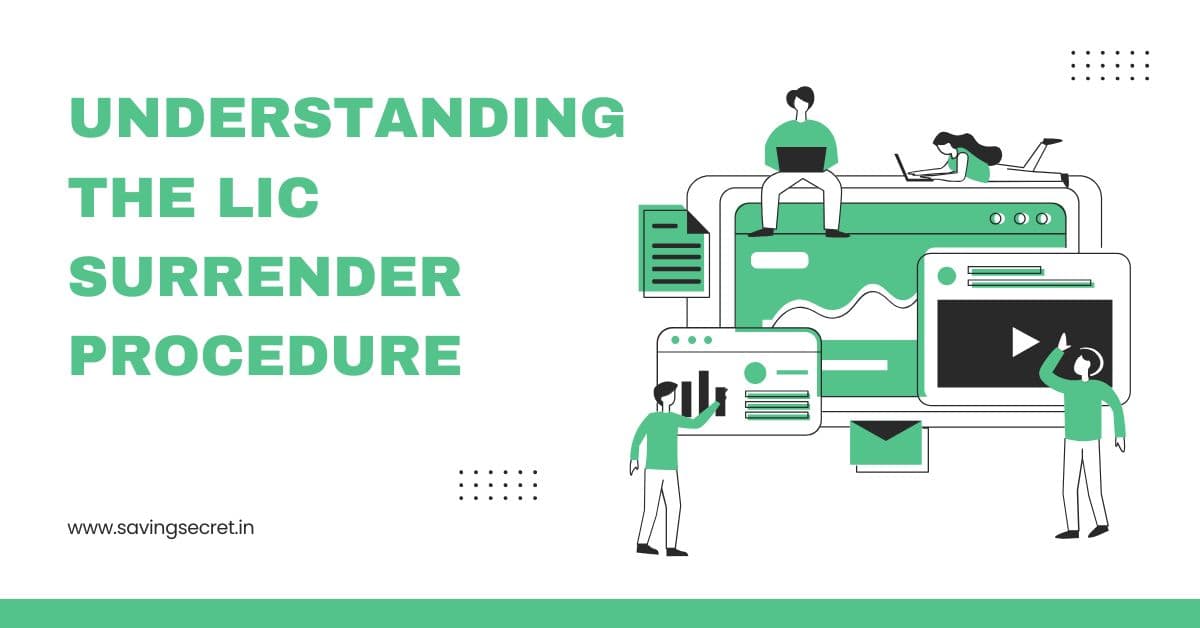LIC Surrender Form Guide: Offering investment programs and life insurance to millions of Indians, the Life Insurance Corporation of India (LIC) is a well-known brand in Indian homes. As a new investor in 2025, though, you could discover that your LIC policy no longer fits your financial objectives because of shifting priorities, budgetary limitations, or more advantageous investing possibilities. Liquidity may be obtained by surrendering a LIC policy—cancelling it before maturity—but there are drawbacks, such as reduced returns and loss of life insurance. It is essential to comprehend the LIC surrender form procedure in order to prepare your future financial move and make well-informed judgements.
This guide, written specifically for Indian investors, outlines the process of relinquishing a LIC insurance using Form 5074, discusses the ramifications, and suggests other ways to maximise your financial situation. This article equips new investors in Tier-2 towns, Delhi, Mumbai, and other cities with useful advice, resources, and insights unique to India, enabling them to successfully complete the surrender process and secure a stable financial future.
Why Think About Giving Up a LIC Policy?
When you surrender a LIC policy, you stop paying premiums before it matures and get a surrender value, which is a percentage of the premiums paid less any fees. The following are typical explanations for Indian investors’ surrender policies:

- Financial Difficulties: Budgets are strained by EMIs, rent (₹15,000–₹30,000 in metro areas), or medical crises (₹50,000–₹5 lakh).
- Better Options: Higher returns or affordability are provided by equity mutual funds (~12% CAGR) or term insurance (₹1 crore cover for ₹487/month).
- Changing Objectives: Liquidity is necessary when objectives change, such as paying for a wedding (₹10–20 lakh) or education (₹5–15 lakh).
- Policy Misalignment: Low returns (LIC plans: 5–6% IRR) or high premiums don’t correspond with today’s financial demands.
Context: LIC is a dependable company with 2.19 crore policies sold in FY 2019–20 and a 98.2% claim settlement ratio; nonetheless, surrendering is frequent when policies don’t perform as expected or when financial demands change.
Be advised that LIC discourages surrendering since you forfeit your life insurance and the surrender value is far less than the maturity advantages.
Understanding the LIC Surrender Procedure
Form 5074 (Surrender Discharge Voucher) and accompanying documentation must be sent in at a LIC branch in order to surrender a LIC policy. This is a thorough handbook for first-time Indian investors.

Step 1: Verify Your Surrender Eligibility
Not every policy is eligible for instant surrender. The kind of coverage and premium payments determine eligibility:
After the second year, single premium plans are surrenderable.
Standard Premium Plans:
- Policies with a 10-year term: Give up after two years of paying premiums.
- Policies longer than ten years: Give up after three years of paying premiums.
Minimum Premiums: For standard insurance to be eligible for a surrender value, premiums must be paid for at least three years.
Context: Without fully comprehending long-term obligations, many new investors purchase LIC plans like as Jeevan Labh or New Jeevan Anand. To verify eligibility, see your policy paperwork or get in touch with your LIC agent.
Step 2: Comprehend the value of surrender
The sum you get when you give up is known as the surrender value, and it is determined by:
About 30% of the total premiums paid, minus taxes, rider premiums, and first-year premiums, is the guaranteed surrender value (GSV).
Value of Special Surrender (SSV):
- Premiums for three to four years: 80% of the guaranteed maturity total.
- 90% of the maturity amount is guaranteed in 4–5 years.
- After five years: A larger proportion that takes accumulated bonuses into account.
Formula: {Basic Sum Assured × (Number of Premiums Paid / Total Premiums Payable) + Total Bonus} × Surrender Value Factor (SVF) is the formula for GSV.
For instance:
- Policy: 5 years, ₹5 lakh total promised, ₹25,000 premium each year.
- A total of ₹1.25 lakh was spent on premiums.
- GSV: about 30% of 1 lakh (without including the first-year premium) equals 30,000 rupees.
- SSV: SSV = (₹5 lakh × 5/20 + ₹50,000) × 50% = ₹87,500 if SVF is 50% and bonus is ₹50,000.
- You get ₹87,500, which is the higher of GSV or SSV.
Context: Early departures are discouraged by low surrender values (SVF close to 0% for 1-3 years). Consult an agent or use the LIC website’s Surrender Value Calculator.
Step 3: Compile the necessary paperwork
Send the following to your servicing LIC branch in order to surrender:
- LIC Surrender Discharge Voucher Form 5074: Get it via LIC’s website or pick it up in person at a branch.
- Original Policy Document: Provide an indemnification bond or affidavit if it is lost.
- Cancelled Check: For a NEFT transfer, provide the policyholder’s name.
- KYC Documents: Driver’s license, PAN, or Aadhaar.
- A handwritten letter outlining the cause of surrender (such as financial difficulties).
- For the direct bank transfer of surrender value, use the NEFT Mandate Form.
Context: Since LIC requires NEFT payments, make sure your bank account complies with KYC. If branches are located far away, rural investors may experience delays; documentation should be couriered to LIC’s headquarters (Yogakshema Building, Mumbai).
Step 4: Fill out LIC Form 5074 after downloading it
The formal surrender discharge voucher is Form 5074. Take these actions:
Get the Form Here:
- On the official LIC website, go to “Customer Portal” > “Download Forms” > In “Policy Servicing,” choose “Form 5074.”
- Alternatively, pick it from the LIC branch that is closest to you (2048 branches countrywide).
Complete the form:
- Name, address, and phone number are personal details.
- Details of the policy: policy number, amount of premiums, and sum assured.
- Give a brief explanation of the surrender reason, such as “financial constraints.”
- Bank Information: Bank name, IFSC code, and account number.
- Sign in accordance with the policy documents. Policyholders who are illiterate must provide a thumb impression or witness.
Double-check: To prevent delays, make sure everything is accurate.
Context: In places with inadequate internet, such as rural Uttar Pradesh and Bihar, download problems are frequent. Go to a branch or amend forms online using tools like pdfFiller.
Step 5: Send in the paperwork and form
- In Person: Go to the LIC branch where the policy was purchased for service. Send in your paperwork and Form 5074.
- By Courier: Send papers to the LIC Head Office, Yogakshema Building, Jeevan Bima Marg, P.O. Box No-19953, Mumbai-400021, if a branch visit is not possible.
- Depending on verification, processing time might range from two to four weeks.
- Verification: Your bank account gets credited with the surrender value using NEFT.
Context: Rural branches take longer to process than metro branches (Delhi, Chennai). Check the status with the LIC mobile app or LIC customer service (1800-33-4433).
Step 6: Recognise the Consequences
Giving up a LIC policy has serious repercussions:
- Loss of Life Coverage: Your family is not financially protected.
- Lower Returns: Surrender value is around 30 to 50% of premiums paid, which is much less than maturity benefits (for example, a policy worth ₹5 lakh may give ₹1 to 2 lakh).
- Tax Implications: If the insurance is relinquished before the five-year mark, premiums claimed under Section 80C may be subject to taxes. Unless bonuses above certain levels, surrender value is tax-free.
- Premiums for future insurance are higher at later ages (e.g., ₹10,000/year at 25 vs. ₹20,000 at 35).
Context: For joint-family breadwinners, losing life insurance is dangerous. For reasonably priced coverage, think about post-surrender term insurance (LIC’s New Jeevan Amar, for example).
Alternatives to Dropping Your LIC Policy
Examine these choices before giving up in order to preserve value or satisfy financial obligations:

1. Make the switch to a paid policy
- What It Is: The policy continues with a lower sum insured; premiums are stopped after two to three years.
- For instance, a ₹5 lakh insurance with five years of premiums accrues ₹1.5 lakh in sum assured, which is due at maturity.
- Ideal For: Investors seeking advantages but unable to pay premiums.
Context: Well-liked by paid professionals who are struggling with EMIs (₹10,000–₹20,000/month) or losing their jobs.
2. Apply for a Loan for a Policy
- What It Is: Pay 9–10% interest on a loan up to 90% of the surrender value.
- For instance, a ₹90,000 loan with flexible repayment terms is possible with a ₹1 lakh surrender value.
- Ideal For: Short-term cash requirements (such as school tuition or medical expenditures).
Context: LIC branches offer loans, which is perfect for rural investors who don’t want to give up.
3. Withdrawal in Part
- The purpose of this strategy is to withdraw a portion of the fund (for unit-linked plans like LIC SIIP).
- Ideal For: Those who want money without terminating the coverage.
In the context, endowment plans like as Jeevan Labh are more widespread than ULIPs.
4. Make the move to a term insurance policy
- What It Is: For more coverage at a reduced cost, surrender the policy and get a term plan (for example, ₹1 crore cover for ₹487/month).
- Ideal For: Young investors that value security above profits.
Context: Due to their cost-effectiveness, term plans are becoming more popular in cities like Bangalore and Hyderabad.
What a New Investor Should Do Next
Once your LIC policy has been surrendered, make prudent use of the surrender value and follow these steps to rebuild your financial plan:
1. High-interest debt that is clear
- Why: To reduce interest costs, pay off personal loans (12–18%) or credit card debt (36% APR).
- For instance, you may save ₹36,000 year on interest by using ₹1 lakh of your surrender value to pay off a ₹1 lakh credit card EMI.
- Context: Debt relief frees cash flow; metro families manage EMIs (₹15,000–₹30,000).
2. Establish an Emergency Fund
- Why: To prevent future surrenders, save aside ₹1–3 lakh, or six to twelve months’ worth of spending, in a liquid fund or savings account.
- Context: Track savings with applications like Moneycontrol; medical crises costing between ₹50,000 and ₹5 lakh are frequent.
3. Make Higher-Return Investments
- Equity Mutual Funds: Sensex fund SIPs (~12% CAGR) using Groww or Zerodha platforms. For instance, ₹5,000 a month for ten years is ₹12.3 lakh.
- ELSS Funds: Section 80C tax-saving funds with 12–15% returns that can be deducted up to ₹1.5 lakh.
- Sovereign Gold Bonds (SGBs): tax-free after eight years, plus 2.5% interest and gold price growth.
- Context: For disciplined investment, young investors in IT centres like SIPs (2 crore+ accounts in 2025).
4. Purchase Term Insurance
- Why: Replace the life cover that was lost due to surrender. For ₹500–₹1,000 per month, LIC’s New Jeevan Amar or private plans provide ₹1 crore coverage.
- Context: Crucial for coupled households with sole wage earners, guaranteeing financial stability.
5. Speak with a Financial Advisor
For this reason, professionals match investments to objectives (e.g., ₹10 lakh for a home in 5 years). AapkaPolicyWala and Holistic Investment are two platforms that provide advice.
Context: YouTube channels (CA Rachana Ranade and Ankur Warikoo) help narrow the financial literacy gap in Tier-2 and Tier-3 cities.
Problems and Solutions for New Investors
Problem 1: Low Surrender Value
Investors are disappointed with surrender values, which range from about 30% to 50% of premiums. Solution: To keep some perks, choose loans or paid-up status.
Problem 2: Intricate Procedure
Beginners are confused by Form 5074 and document submission. Solution: Seek advice from LIC’s customer service department (1800-33-4433) or internet resources such as DocHub.
Problem 3: Attachment on an emotional level
Giving up is difficult in LIC because of cultural trust. Solution: To support the move, compare the returns of mutual funds (12%) and LIC (5–6%).
Problem 4: Tax ambiguity
Reversing 80C deductions is possible if you surrender before five years. Solution: Determine your tax obligations with ClearTax.
Context: LIC’s app and courier services make it easier for investors in rural areas to visit branches.
Resources and Tools for Investing
- LIC Portal: Track status, verify surrender value, or download Form 5074.
- LIC Mobile App: For information on policies, use the iOS or Android app.
- Financial platforms: for post-surrender investing include Moneycontrol, Groww, and Zerodha.
- Tax tools: for ITR filing and tax preparation include ClearTax and TaxSpanner.
- Learning Resources: YouTube (Pranjal Kamra, Ankur Warikoo), SEBI’s investor portal, and NSE India.
- Community: For peer guidance, join Reddit’s r/IndiaInvestments group.
Context: Rural regions and non-English speaking populations are served by LIC’s 2048 branches and Hindi services.
Conclusion
New investors in India may find liquidity by surrendering a LIC policy using Form 5074, but because of the low surrender values and loss of life coverage, this is a move that needs to be carefully considered. You can obtain money to cover urgent necessities by completing the surrender procedure, which includes determining your eligibility, obtaining supporting documentation, and submitting the form. To preserve value, look at options like loans or paid-up plans. To safeguard your financial future in 2025 after surrender, pay off high-interest debt, accumulate an emergency fund, and make investments in high-return products like mutual funds or term insurance.
Call to Action: Begin the process of surrendering right now! You may verify your surrender value via the LIC app, download Form 5074 from the LIC website, or speak with an agent. For professional advice, join r/IndiaInvestments or leave a comment with your intentions!
Gold Investment Planning: Here’s How to Start Your Golden Journey
Nifty 50 Investment Guide for Beginners
Government Bonds for Beginners: Buy Online Easily

